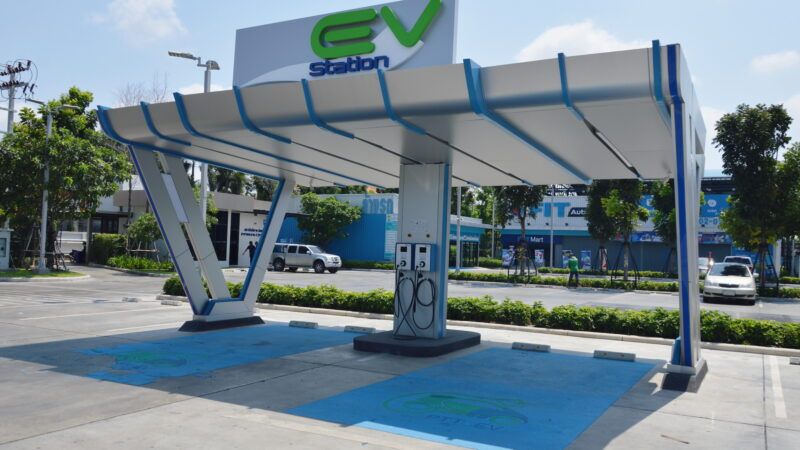$7.5 Billion in Government Cash Only Built 8 E.V. Chargers in 2.5 Years
While the private sector builds hundreds of public chargers, the government spends billions of dollars for just a handful of charging stations.

In 2021, the Infrastructure Investment and Jobs Act included $7.5 billion to build 500,000 public charging stations for electric vehicles (E.V.s) across the country in an effort to boost a switch to the use of clean energy.
As Reason reported in December, not one charger funded by the program had yet come online. Now, six months later, the number of functional charging stations has ticked up to eight.
That news comes from an Autoweek article earlier this month. In March, The Washington Post reported that only seven were built; a charging station in Bradford, Vermont, opened in April, containing four E.V. fast chargers. Public chargers are either Level 2, which use alternating current electricity and take several hours to fully charge an all-electric vehicle from empty, or Direct Current Fast Charging (DCFC) superchargers, which use direct current and can charge in less than an hour.
Why so little progress? Alexander Laska of the center-left Third Way think tank told Autoweek's Jim Motavalli that the federal cash "comes with dozens of rules and requirements around everything from reliability to interoperability, to where stations can be located, to what certifications the workers installing the chargers need to have." Laska says the regulations "are largely a good thing—we want drivers to have a seamless, convenient, reliable charging experience—but navigating all of that does add to the timeline."
A spokesperson with the National Electric Vehicle Infrastructure (NEVI) program, which administers $5 billion of the $7.5 billion total, further told Motavalli that the delay is because "we want to get it right."
Thankfully, federal grants aren't the only way to build out charging infrastructure.
"US drivers welcomed almost 1,100 new public, fast-charging stations in the second half of 2023, a 16% increase," Bloomberg's Kyle Stock reported in January. And not just in big cities or progressive enclaves: Deep-red Idaho "switched on 12 new [DCFCs] between July and December," while "Alabama, Arkansas, Mississippi and Tennessee welcomed 56 new fast-charging stations in the second half of 2023, an infrastructure increase of one-third."
While Stock notes that $5 billion of federal money is expected to roll out soon, "the vast majority of chargers added in the US last year were bets by for-profit companies on the future of battery-powered driving."
The most prominent company by far is Tesla, whose network of Superchargers includes over 57,000 DCFC chargers around the world and generated an estimated $1.74 billion of revenue in 2023 alone. Just in the fourth quarter of 2023, the company built 357 new stations, accounting for 3,783 charging ports.
Around two-thirds of all public chargers in the U.S. are manufactured for Teslas, but the company has also expanded its network for its competitors to use: In the 2025 model year, most major automakers' E.V.s will use the same charge port as Teslas and be able to access the Supercharger network.
Rivian, a Tesla competitor, is also building out its own DCFC network: In February 2024, it counted 400 chargers in 67 locations, with plans to expand further, and just like with Tesla's Superchargers, Rivian plans to make its chargers accessible to other models.
In fairness, both Tesla and Rivian have benefited from government handouts: State and local governments in Georgia promised Rivian a raft of incentives worth up to $1.5 billion. And Tesla has received at least $2.8 billion in federal, state, and local subsidies over the years, despite CEO Elon Musk's professed distaste for government intervention in the economy. In fact, Politico found in February that Tesla was the single largest recipient of funds disbursed by the federal NEVI program, winning "almost 13 percent of all EV charging awards from the law, earning it a total of more than $17 million in infrastructure grants."
But those companies still provide the best template for expanding access to public chargers.
While proponents of the federal regulations may defend the amount of red tape involved in the federal program, with demands on where a charging station can be placed and the types of licenses people need to build one, the fact is that the private sector is already building out a nationwide E.V. charging network that will be available to most drivers.


Show Comments (46)